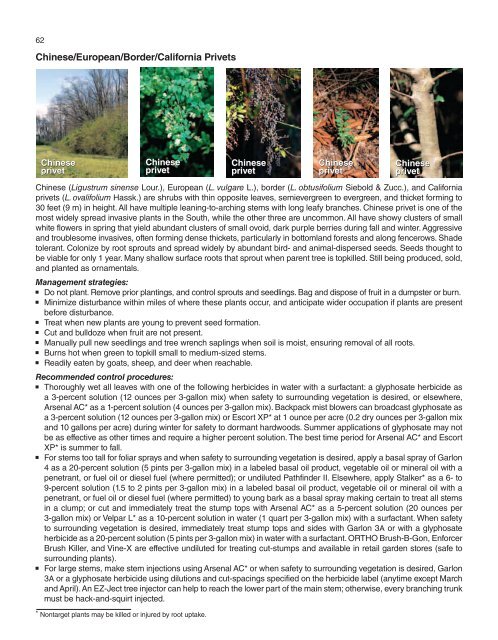A Management Guide for Invasive Plants in Southern Forests James ...
A Management Guide for Invasive Plants in Southern Forests James ...
A Management Guide for Invasive Plants in Southern Forests James ...
- No tags were found...
Create successful ePaper yourself
Turn your PDF publications into a flip-book with our unique Google optimized e-Paper software.
62Ch<strong>in</strong>ese/European/Border/Cali<strong>for</strong>nia PrivetsCh<strong>in</strong>eseprivetCh<strong>in</strong>eseprivetCh<strong>in</strong>ese (Ligustrum s<strong>in</strong>ense Lour.), European (L. vulgare L.), border (L. obtusifolium Siebold & Zucc.), and Cali<strong>for</strong>niaprivets (L. ovalifolium Hassk.) are shrubs with th<strong>in</strong> opposite leaves, semievergreen to evergreen, and thicket <strong>for</strong>m<strong>in</strong>g to30 feet (9 m) <strong>in</strong> height. All have multiple lean<strong>in</strong>g-to-arch<strong>in</strong>g stems with long leafy branches. Ch<strong>in</strong>ese privet is one of themost widely spread <strong>in</strong>vasive plants <strong>in</strong> the South, while the other three are uncommon. All have showy clusters of smallwhite flowers <strong>in</strong> spr<strong>in</strong>g that yield abundant clusters of small ovoid, dark purple berries dur<strong>in</strong>g fall and w<strong>in</strong>ter. Aggressiveand troublesome <strong>in</strong>vasives, often <strong>for</strong>m<strong>in</strong>g dense thickets, particularly <strong>in</strong> bottomland <strong>for</strong>ests and along fencerows. Shadetolerant. Colonize by root sprouts and spread widely by abundant bird- and animal-dispersed seeds. Seeds thought tobe viable <strong>for</strong> only 1 year. Many shallow surface roots that sprout when parent tree is topkilled. Still be<strong>in</strong>g produced, sold,and planted as ornamentals.<strong>Management</strong> strategies:Do not plant. Remove prior plant<strong>in</strong>gs, and control sprouts and seedl<strong>in</strong>gs. Bag and dispose of fruit <strong>in</strong> a dumpster or burn.M<strong>in</strong>imize disturbance with<strong>in</strong> miles of where these plants occur, and anticipate wider occupation if plants are presentbe<strong>for</strong>e disturbance.Treat when new plants are young to prevent seed <strong>for</strong>mation.Cut and bulldoze when fruit are not present.Manually pull new seedl<strong>in</strong>gs and tree wrench sapl<strong>in</strong>gs when soil is moist, ensur<strong>in</strong>g removal of all roots.Burns hot when green to topkill small to medium-sized stems.Readily eaten by goats, sheep, and deer when reachable.Recommended control procedures:Thoroughly wet all leaves with one of the follow<strong>in</strong>g herbicides <strong>in</strong> water with a surfactant: a glyphosate herbicide asa 3-percent solution (12 ounces per 3-gallon mix) when safety to surround<strong>in</strong>g vegetation is desired, or elsewhere,Arsenal AC* as a 1-percent solution (4 ounces per 3-gallon mix). Backpack mist blowers can broadcast glyphosate asa 3-percent solution (12 ounces per 3-gallon mix) or Escort XP* at 1 ounce per acre (0.2 dry ounces per 3-gallon mixand 10 gallons per acre) dur<strong>in</strong>g w<strong>in</strong>ter <strong>for</strong> safety to dormant hardwoods. Summer applications of glyphosate may notbe as effective as other times and require a higher percent solution. The best time period <strong>for</strong> Arsenal AC* and EscortXP* is summer to fall.For stems too tall <strong>for</strong> foliar sprays and when safety to surround<strong>in</strong>g vegetation is desired, apply a basal spray of Garlon4 as a 20-percent solution (5 p<strong>in</strong>ts per 3-gallon mix) <strong>in</strong> a labeled basal oil product, vegetable oil or m<strong>in</strong>eral oil with apenetrant, or fuel oil or diesel fuel (where permitted); or undiluted Pathf<strong>in</strong>der II. Elsewhere, apply Stalker* as a 6- to9-percent solution (1.5 to 2 p<strong>in</strong>ts per 3-gallon mix) <strong>in</strong> a labeled basal oil product, vegetable oil or m<strong>in</strong>eral oil with apenetrant, or fuel oil or diesel fuel (where permitted) to young bark as a basal spray mak<strong>in</strong>g certa<strong>in</strong> to treat all stems<strong>in</strong> a clump; or cut and immediately treat the stump tops with Arsenal AC* as a 5-percent solution (20 ounces per3-gallon mix) or Velpar L* as a 10-percent solution <strong>in</strong> water (1 quart per 3-gallon mix) with a surfactant. When safetyto surround<strong>in</strong>g vegetation is desired, immediately treat stump tops and sides with Garlon 3A or with a glyphosateherbicide as a 20-percent solution (5 p<strong>in</strong>ts per 3-gallon mix) <strong>in</strong> water with a surfactant. ORTHO Brush-B-Gon, En<strong>for</strong>cerBrush Killer, and V<strong>in</strong>e-X are effective undiluted <strong>for</strong> treat<strong>in</strong>g cut-stumps and available <strong>in</strong> retail garden stores (safe tosurround<strong>in</strong>g plants).For large stems, make stem <strong>in</strong>jections us<strong>in</strong>g Arsenal AC* or when safety to surround<strong>in</strong>g vegetation is desired, Garlon3A or a glyphosate herbicide us<strong>in</strong>g dilutions and cut-spac<strong>in</strong>gs specified on the herbicide label (anytime except Marchand April). An EZ-Ject tree <strong>in</strong>jector can help to reach the lower part of the ma<strong>in</strong> stem; otherwise, every branch<strong>in</strong>g trunkmust be hack-and-squirt <strong>in</strong>jected.* Nontarget plants may be killed or <strong>in</strong>jured by root uptake.Ch<strong>in</strong>eseprivetCh<strong>in</strong>eseprivetCh<strong>in</strong>eseprivet
















